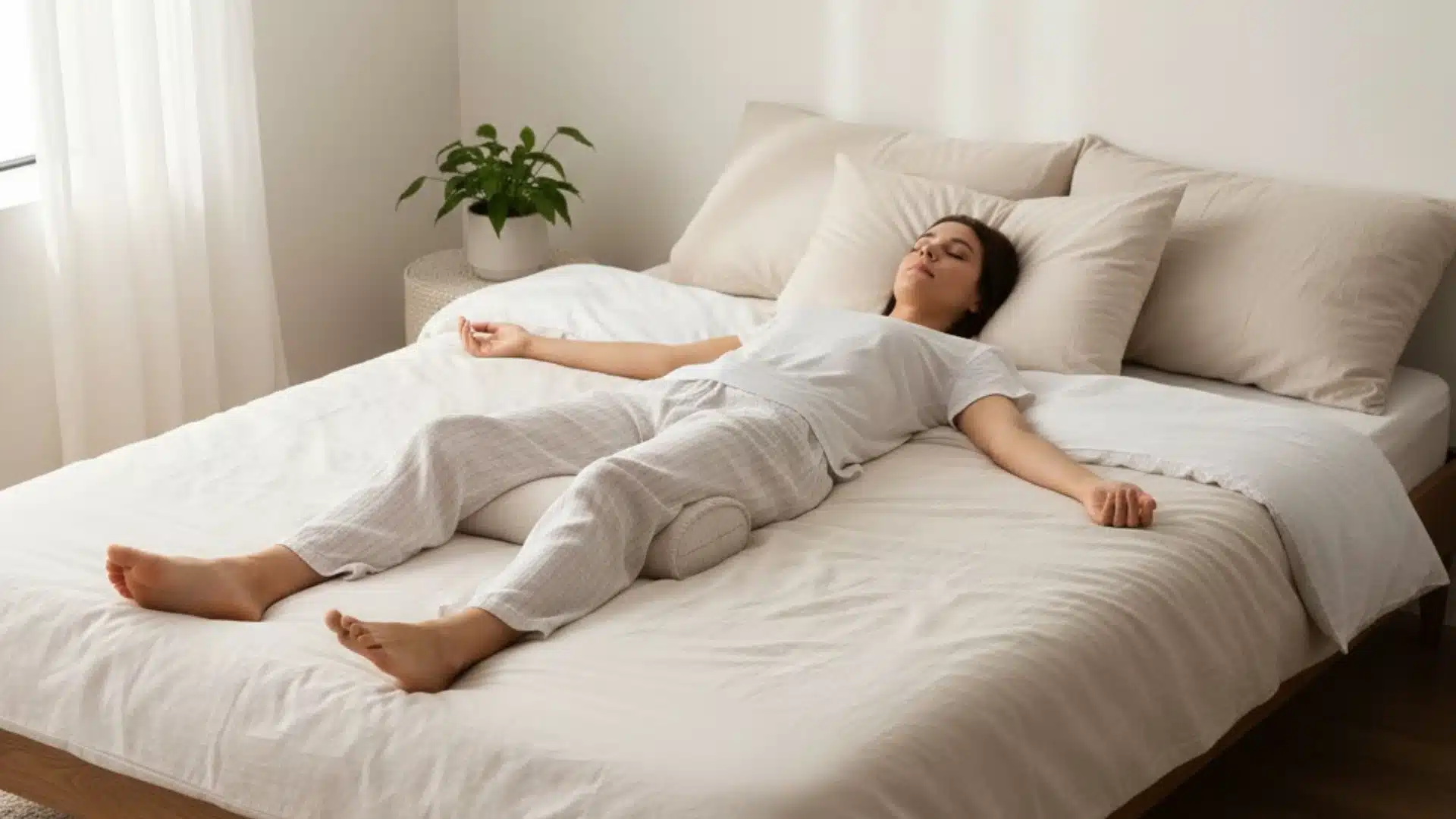I used to wake up every morning with a stiff neck and aching shoulders, wondering why sleep, something that’s supposed to be restorative, left me feeling worse.
Here’s what I’ve learned: your sleeping position has everything to do with spinal alignment, and when your neck and shoulders spend hours twisted or unsupported, they rebel the next day.
In this guide, I’ll walk you through the best sleep positions for pain relief, how to choose the right pillow and mattress, what habits to avoid, and when it’s time to consult a professional.
Let’s fix those painful mornings together!
What Causes Neck and Shoulder Pain During Sleep?
Morning pain usually stems from how we position ourselves at night. When your pillow is too high or too flat, your neck bends unnaturally for hours.
Side sleepers often crush their shoulder into the mattress without proper support, while stomach sleepers force their neck into constant rotation. A sagging mattress creates uneven pressure points that throw everything off balance.
Sleep doesn’t always cause the problem; it just amplifies existing issues. That tension from hunching over your phone all day? It tightens further overnight.
Old injuries, chronic stress, and rotator cuff irritation all worsen when your body can’t fully relax during sleep. Understanding what’s happening helps you make the right adjustments for real relief.
Best Sleeping Positions for Neck & Shoulder Pain

Your sleeping position can either heal or hurt you. I’ve tested these positions myself, and the difference is remarkable when you get the details right.
1. Back Sleeping: Best Overall for Neck Pain
This position keeps your spine in neutral alignment, distributing weight evenly. Use a medium-loft pillow that supports your neck’s natural curve without pushing your head too far forward.
Adding a pillow under your knees takes pressure off your lower back. This works beautifully for chronic neck pain sufferers, though it may worsen snoring for some people.
2. Side Sleeping: Best for Shoulder Relief When Done Right
Side sleeping maintains spinal alignment if your pillow height matches the distance from your ear to your shoulder. Use a firm, high-loft pillow to fill this gap.
Hug a body pillow to open your chest and prevent the top shoulder from rolling forward. Place a thin pillow between your knees to stop hip rotation. The left side helps digestion; switch to the right if your left shoulder hurts.
3. Modified Side-Back Position
This halfway tilt using a wedge or body pillow reduces direct shoulder pressure while keeping your spine neutral. You’re not fully on your side or back; just angled enough to relieve the shoulder without rotating your neck.
Perfect for people who can’t commit to pure back sleeping but need shoulder relief.
Position to Avoid
Stomach sleeping forces your neck into constant rotation for hours, straining muscles and compressing nerves.
If you absolutely can’t break this habit, use an ultra-thin pillow or none at all, and try placing a pillow under your pelvis to reduce the arch in your lower back.
How to Sleep With Neck Pain: Pillow and Mattress Adjustments
The right pillow can make or break your sleep quality. I’ve learned that matching your pillow to your sleeping position is non-negotiable for neck relief.
Choosing the Right Pillow Loft and Material
Pillow height matters more than you’d think. Back sleepers with smaller frames need low-loft pillows, while most back sleepers do well with medium loft. Side sleepers require high-loft pillows to fill the gap between the ear and the mattress.
Material affects support quality too: memory foam contours precisely to your neck curves, latex offers springy, breathable support, and feather-down allows customization but lacks structure.
Choose based on whether you need firm contouring or adjustable softness.
When Cervical Pillows Make a Difference
Cervical pillows have a curved design that cradles your neck’s natural arch while supporting your head at the correct angle. They’re especially helpful if you have tech neck, rounded shoulders, or chronic morning stiffness.
The contoured shape keeps your cervical spine aligned throughout the night. Some have higher sides for side sleeping and a dip in the middle for back sleeping.
They take a few nights to adjust to, but the support they provide often outweighs the initial strangeness.
Mattress Factors That Influence Neck & Shoulder Pain
Your mattress plays a massive role in how your body aligns overnight. If it’s too soft, you sink and lose support; too firm, and your shoulders bear excessive pressure.
| Mattress Factor | The Problem | The Solution |
|---|---|---|
| Too Soft | Body sinks unevenly, throwing off spinal alignment | Choose medium to medium-firm for back sleepers |
| Too Firm | Creates pressure points on the shoulders and hips | Choose medium-soft to medium for side sleepers |
| Zoned Support | Standard mattresses apply uniform pressure everywhere | Look for softer shoulder zones with firmer hip support |
| Shoulder Cut-Outs | Side sleepers get shoulder compression against flat surfaces | Indentations let shoulders sink while spine stays aligned |
| Sagging/Age | Dips develop over time, misaligning the spine and straining the neck | Replace every seven to ten years or when visibly sagging |
If you’re waking up sore despite good pillows and sleep positions, your mattress might be the culprit. Testing a new mattress or adding a topper can reveal whether it’s time for an upgrade.
How to Sleep With Shoulder Pain: Modifications That Help

Shoulder pain at night often comes from compression or awkward arm angles. These simple adjustments can keep pressure off the painful area while you sleep.
- Sleep on your opposite side and use a body pillow to prevent rolling onto the affected shoulder during the night.
- Keep your arms down by your sides or hug a pillow; never sleep with your arm overhead, as this compresses the rotator cuff.
- Place a small pillow under your armpit to create space and reduce direct shoulder compression against the mattress.
- Use a wedge pillow behind your back to support a slight recline, distributing weight more evenly across your torso.
- Hug a body pillow lengthwise to open your chest and stop your top shoulder from rolling forward.
Experiment with these positions to find what feels most natural. Even small tweaks can dramatically reduce morning stiffness and pain.
Simple Bedtime Habits That Reduce Pain
What you do before bed sets the stage for how you’ll feel in the morning. These habits prepare your muscles to relax fully overnight.
- Take a warm shower or apply a heat pad to your neck and shoulders to loosen tight muscles before lying down.
- Do gentle neck rolls and upper back stretches to release built-up tension from the day.
- Put away screens at least an hour before bed; the hunched posture tightens your neck and shoulder muscles.
- Practice mindful breathing or progressive muscle relaxation to consciously release the shoulder tension you’re holding.
Building these into your nightly routine takes just minutes but can transform how your body recovers during sleep.
Morning Tips to Reduce Stiffness
How you wake up matters just as much as how you sleep. Rushing out of bed with tight muscles can trigger pain that lasts all day.
- Stay in bed for a minute and do slow neck rotations in both directions to gently wake up stiff muscles.
- Stand in a doorway and stretch your chest by placing your forearms on the frame and leaning forward to open your shoulders.
- Roll your shoulders backward several times, then gently tilt your head to each side to stretch your upper traps.
- Transition slowly from lying to sitting to standing; give your spine time to decompress and adjust to gravity.
These few minutes of gentle movement can prevent that sharp morning stiffness from snowballing into a painful day.
When to See a Doctor or PT?
Most sleep-related neck and shoulder pain improves with better positioning and pillow adjustments within a week or two. If your pain persists beyond that, something deeper might be going on.
See a healthcare provider if you experience numbness, tingling, or weakness radiating down your arm; these signals nerve involvement. Severe pain following an injury needs immediate evaluation to rule out structural damage.
Persistent limited range of motion, like being unable to turn your head or lift your arm, also warrants professional assessment.
A physical therapist can identify underlying issues and create a targeted treatment plan beyond sleep modifications.
The Bottom Line
Learning how to sleep with neck and shoulder pain has genuinely changed my mornings.
Small adjustments: switching positions, choosing the right pillow height, upgrading a worn mattress, add up to real relief.
Your body spends a third of its life in bed, so making those hours work for you instead of against you is worth the effort. Start with one change tonight, whether it’s adding a body pillow or trying back sleeping with proper support.
Have questions or tips that worked for you? Drop a comment below; I’d love to hear what’s helped your pain improve.









